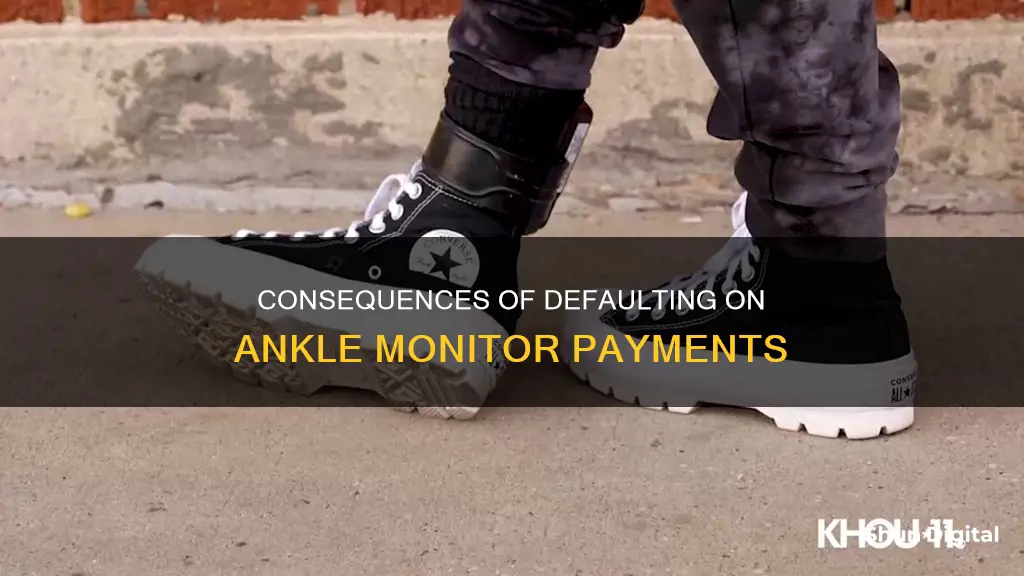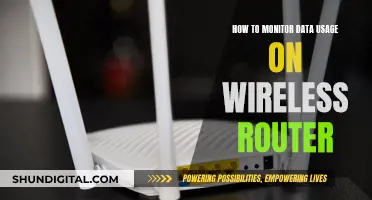
Ankle monitors are often used as an alternative to jail time, allowing individuals to remain free while awaiting trial or serving probation. However, the use of these monitors has sparked controversy, as they are usually accompanied by significant fees that the wearer is expected to pay. These fees, which can range from $3 to $35 per day, are charged by private companies that provide the monitoring service. For individuals who are already struggling financially, these costs can be burdensome and may even lead to a cycle of debt and further incarceration. While some may argue that the monitored individual chose to commit a crime and should bear the consequences, others question the ethics of profiting from the criminal justice system and further punishing those who are often already disadvantaged.
| Characteristics | Values |
|---|---|
| Who pays for the ankle monitor | The wearer has to pay for the cost of the monitor and a daily use fee. |
| Cost of the ankle monitor | Setup fee as high as $200, $3-$35 a day, $100-$200 initial setup charges |
| Effect of non-payment | Jail time |
| Effect on the wearer | Social isolation, stigmatization, stress, and exacerbation of depression and anxiety |
What You'll Learn

You may be forced to pay high fees to private companies
In the US, ankle monitors are often used as an alternative to jail time, allowing individuals to remain free while awaiting trial or serving probation. However, this freedom comes at a cost. Private companies typically charge defendants hundreds of dollars a month to wear these surveillance devices, and if they can't pay, they may end up back in jail.
The fees associated with ankle monitors can be significant, ranging from $3 to $35 per day, on top of initial setup charges that can reach $200 or more. For those who cannot afford these costs, ankle monitors can become a financial burden, leading to debt and further legal consequences. In some cases, individuals may be forced to choose between paying for the monitor or covering basic necessities like food and housing.
The high fees charged by private companies can create a cycle of debt and incarceration, particularly for those from low-income backgrounds. This raises questions about the fairness of a system that allows private companies to profit from the criminal justice system and places an additional financial burden on those who can least afford it.
While ankle monitors are intended to provide an alternative to incarceration, the high fees associated with them can create a new form of oppression, trapping individuals in a system that exploits their financial situation. This contradicts the goal of fostering social reintegration and rehabilitation, instead creating a "digital jail" that further entangles individuals in the criminal justice system.
The financial implications of ankle monitors are a significant concern, and the high fees charged by private companies can have far-reaching consequences for those required to wear these devices.
Monitoring the ASUS AC 3100: Tracking Visited Websites
You may want to see also

You could be sent back to jail
Ankle monitors are often used as an alternative to jail time, allowing individuals to remain free while awaiting trial or serving probation. However, if a person cannot afford the fees associated with the ankle monitor, they may find themselves back behind bars. This is because the cost of the monitor is typically the responsibility of the individual wearing it, and failure to pay can result in a violation of the terms of their release.
In the United States, the cost of ankle monitors can range from $3 to $35 per day, with initial setup charges ranging from $100 to $200. These fees can be a significant financial burden, especially for those who are already struggling economically. For example, in St. Louis, Missouri, individuals released from jail with an ankle monitor are required to pay $10 per day to a private company for the device. This amount is in addition to any installation and upfront fees, which can total several hundred dollars.
If an individual cannot afford the cost of the ankle monitor, they may face consequences such as a warrant for their arrest and a return to jail. This was the case for Daehaun White, a 19-year-old from St. Louis who was unable to pay the daily fee for his ankle monitor after being released from jail. As a result, a judge issued a warrant for his arrest, and he was taken back into custody.
The inability to pay for an ankle monitor can also lead to further legal troubles. In some cases, individuals who cannot afford the cost of the device may be charged with additional violations or face increased bail amounts. This can create a cycle of debt and incarceration, particularly for those who are already struggling financially.
Furthermore, the use of ankle monitors can also impact an individual's ability to find employment and maintain social connections. The stigma associated with wearing an ankle monitor can make it difficult to find work, as employers may be hesitant to hire someone with a criminal record or who is currently under supervision. Additionally, the restrictions on movement and the need to regularly check in with a probation officer can interfere with work and social obligations.
Overall, the financial burden of ankle monitors can be a significant barrier for individuals trying to reintegrate into society after a conviction. The inability to pay for these devices can lead to further legal troubles, including a return to jail, and can exacerbate the challenges faced by those trying to rebuild their lives.
Best ASUS Monitors for 2K 144Hz Gaming Experience
You may want to see also

It could be hard to find employment
Ankle monitors are often touted as a more humane alternative to jail time, but the reality is that they can pose significant financial challenges for those who have to wear them. The cost of renting and maintaining these devices can quickly add up, and for individuals who are already facing economic hardships, this additional expense can be overwhelming. This is especially true for those who are unemployed or have limited financial resources.
The cost of ankle monitors varies depending on the state and the specific device used. In most cases, individuals are charged a daily usage fee, which can range from $5 to $20 per day, plus a one-time setup fee of $100 to $200. These fees must be paid to private companies that provide the monitoring service, and they are non-negotiable. While some states may offer sliding scales based on income, the financial burden can still be significant, especially for those who are already struggling to make ends meet.
For example, consider the case of Daehaun White, a 19-year-old who was released from jail in St. Louis after being charged with tampering with a motor vehicle. As a condition of his release, White was required to wear an ankle monitor and pay $10 per day to Eastern Missouri Alternative Sentencing Services (EMASS). The upfront cost for White to have the monitor attached was $300, which covered the first 25 days, plus a $50 installation fee. For someone who was earning minimum wage and came from a low-income family, this expense was a significant burden.
The financial strain of paying for an ankle monitor can have far-reaching consequences, affecting various aspects of an individual's life. One of the most significant impacts is on employment prospects. Finding a job can be challenging for anyone, but the presence of an ankle monitor can make it even harder. Employers may be hesitant to hire someone with a visible reminder of their involvement with the criminal justice system. The stigma associated with ankle monitors can create a barrier to employment, making it difficult for individuals to find work and improve their financial situation.
Additionally, the restrictions imposed by ankle monitors can interfere with work schedules and opportunities. Individuals may be required to adhere to specific rules and regulations, such as refraining from drinking alcohol or staying within a designated area. These conditions can limit the types of jobs they can pursue and may not align with the requirements of certain professions. The constant surveillance and location tracking can also make it difficult for individuals to find employment, as potential employers may have concerns about hiring someone with a criminal record or perceive the ankle monitor as a sign of unreliability or untrustworthiness.
Furthermore, the financial burden of paying for the ankle monitor itself can be a significant obstacle to employment. With daily fees ranging from $5 to $20, individuals may find themselves in a cycle of debt, struggling to keep up with the payments while also trying to cover their basic living expenses. This financial strain can limit their ability to actively seek employment, purchase appropriate clothing for job interviews, or access necessary resources such as reliable transportation.
The impact of ankle monitors on employment prospects is a significant issue that can have long-term consequences for individuals trying to rebuild their lives after a run-in with the law. While the monitors are intended to provide an alternative to incarceration, the financial burden they impose can create barriers to rehabilitation and reintegration into society. It underscores the need for a more holistic approach to criminal justice reform that addresses the economic challenges faced by individuals involved with the system.
Disabling Standby Mode on Lenovo Monitors: A Step-by-Step Guide
You may want to see also

You may be restricted by geographic limitations
Ankle monitors are often used as an alternative to incarceration, allowing individuals to remain in their community and maintain employment and family connections. However, they can also come with a set of restrictions that limit the wearer's movements and activities. One such restriction is geographic limitations, which can vary depending on the individual's case and the court's ruling.
Geographic limitations may be imposed to restrict the wearer's movements to a specific area, such as their home or a particular neighbourhood. These limitations are monitored through GPS technology, which tracks the wearer's location and alerts authorities if they venture outside the designated area. In some cases, exclusionary zones may be implemented, preventing the wearer from entering certain neighbourhoods or areas of the city. For example, an individual on parole for a drug offence may be forbidden from entering a particular area of the city where their family and childhood friends live.
The consequences of violating these geographic limitations can be severe. In most cases, if the wearer goes outside the specified perimeter, the monitoring device will alert a monitoring station, which can result in law enforcement apprehension. This can lead to arrest and potential jail time for violating the terms of the ankle monitor.
In addition to geographic limitations, individuals with ankle monitors may also be subject to other restrictions, such as meeting with their parole officer, abstaining from drugs and alcohol, and adhering to specific curfews or check-in times. These restrictions aim to ensure the individual's compliance with the court's orders and to reduce the risk of reoffending.
While ankle monitors can provide an alternative to incarceration, the restrictions imposed, including geographic limitations, can significantly impact the wearer's daily life and ability to reintegrate into society. It is important for individuals to understand the rules and potential consequences of violations to maintain their freedom and quality of life.
LCD vs. LED Monitors: Which is Superior?
You may want to see also

You could be forced to plead guilty
Ankle monitors are often presented as a more humane alternative to jail time. However, private companies charge defendants hundreds of dollars a month to wear these devices, and if they can't pay, they may end up behind bars.
In some cases, people have hurried to plead guilty for no better reason than that being on probation was cheaper than paying for an ankle monitor. Pleading guilty means admitting that your conduct is punishable by law and that you are aware of the consequences. Once you plead guilty to a charge, you cannot change your plea afterward. Therefore, it is always advised that you talk with a criminal defense attorney before doing so.
The cost of ankle monitors can be exorbitant, with set-up fees ranging from $175 to $200 and daily fees ranging from $5 to $40. For indigent parolees, these fees are unaffordable, and they may be forced to choose between pleading guilty and incurring more debt.
Additionally, wearing an ankle monitor can negatively impact a person's employment prospects and day-to-day life. The stigma and inconvenience associated with ankle monitors can cause social isolation and humiliation, as people may assume the wearer is a dangerous criminal.
In summary, the high cost of ankle monitors and the difficulties they present in finding and keeping employment can put parolees at risk of debt and force them to plead guilty prematurely.
Monitoring Linux CPU Usage: A Comprehensive Guide
You may want to see also
Frequently asked questions
If you can't pay for your ankle monitor, you may end up in jail. Private companies charge defendants hundreds of dollars a month to wear the surveillance devices.
The person wearing the ankle monitor pays for it.
Fees to wear ankle monitors range from $3 to $35 a day, with initial setup charges ranging from $100 to $200.
If you can't afford an ankle monitor, you may be able to stay in jail instead. However, this is not always an option, and some people end up trapped in a cycle of debt and incarceration.
Some possible alternatives to ankle monitors include court reminders and transportation assistance.







